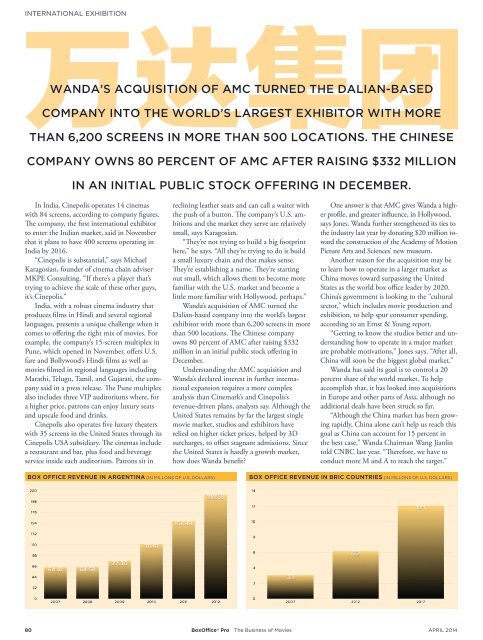Create successful ePaper yourself
Turn your PDF publications into a flip-book with our unique Google optimized e-Paper software.
INTERNATIONAL EXHIBITION<br />
WANDA’S ACQUISITION OF AMC TURNED THE DALIAN-BASED<br />
COMPANY INTO THE WORLD’S LARGEST EXHIBITOR WITH MORE<br />
THAN 6,200 SCREENS IN MORE THAN 500 LOCATIONS. THE CHINESE<br />
COMPANY OWNS 80 PERCENT OF AMC AFTER RAISING $332 MILLION<br />
IN AN INITIAL PUBLIC STOCK OFFERING IN DECEMBER.<br />
In India, Cinepolis operates 14 cinemas<br />
with 84 screens, according to company figures.<br />
The company, the first international exhibitor<br />
to enter the Indian market, said in November<br />
that it plans to have 400 screens operating in<br />
India by 2016.<br />
“Cinepolis is substantial,” says Michael<br />
Karagosian, founder of cinema chain adviser<br />
MKPE Consulting. “If there’s a player that’s<br />
trying to achieve the scale of these other guys,<br />
it’s Cinepolis.”<br />
India, with a robust cinema industry that<br />
produces films in Hindi and several regional<br />
languages, presents a unique challenge when it<br />
comes to offering the right mix of movies. For<br />
example, the company’s 15-screen multiplex in<br />
Pune, which opened in November, offers U.S.<br />
fare and Bollywood’s Hindi films as well as<br />
movies filmed in regional languages including<br />
Marathi, Telugu, Tamil, and Gujarati, the company<br />
said in a press release. The Pune multiplex<br />
also includes three VIP auditoriums where, for<br />
a higher price, patrons can enjoy luxury seats<br />
and upscale food and drinks.<br />
Cinepolis also operates five luxury theaters<br />
with 35 screens in the United States through its<br />
Cinepolis USA subsidiary. The cinemas include<br />
a restaurant and bar, plus food and beverage<br />
service inside each auditorium. Patrons sit in<br />
reclining leather seats and can call a waiter with<br />
the push of a button. The company’s U.S. ambitions<br />
and the market they serve are relatively<br />
small, says Karagosian.<br />
“They’re not trying to build a big footprint<br />
here,” he says. “All they’re trying to do is build<br />
a small luxury chain and that makes sense.<br />
They’re establishing a name. They’re starting<br />
out small, which allows them to become more<br />
familiar with the U.S. market and become a<br />
little more familiar with Hollywood, perhaps.”<br />
Wanda’s acquisition of AMC turned the<br />
Dalian-based company into the world’s largest<br />
exhibitor with more than 6,200 screens in more<br />
than 500 locations. The Chinese company<br />
owns 80 percent of AMC after raising $332<br />
million in an initial public stock offering in<br />
December.<br />
Understanding the AMC acquisition and<br />
Wanda’s declared interest in further international<br />
expansion requires a more complex<br />
analysis than Cinemark’s and Cinepolis’s<br />
revenue-driven plans, analysts say. Although the<br />
United States remains by far the largest single<br />
movie market, studios and exhibitors have<br />
relied on higher ticket prices, helped by 3D<br />
surcharges, to offset stagnant admissions. Since<br />
the United States is hardly a growth market,<br />
how does Wanda benefit?<br />
One answer is that AMC gives Wanda a higher<br />
profile, and greater influence, in Hollywood,<br />
says Jones. Wanda further strengthened its ties to<br />
the industry last year by donating $20 million toward<br />
the construction of the Academy of Motion<br />
Picture Arts and Sciences’ new museum.<br />
Another reason for the acquisition may be<br />
to learn how to operate in a larger market as<br />
China moves toward surpassing the United<br />
States as the world box office leader by 2020.<br />
China’s government is looking to the “cultural<br />
sector,” which includes movie production and<br />
exhibition, to help spur consumer spending,<br />
according to an Ernst & Young report.<br />
“Getting to know the studios better and understanding<br />
how to operate in a major market<br />
are probable motivations,” Jones says. “After all,<br />
China will soon be the biggest global market.”<br />
Wanda has said its goal is to control a 20<br />
percent share of the world market. To help<br />
accomplish that, it has looked into acquisitions<br />
in Europe and other parts of Asia, although no<br />
additional deals have been struck so far.<br />
“Although the China market has been growing<br />
rapidly, China alone can’t help us reach this<br />
goal as China can account for 15 percent in<br />
the best case,” Wanda Chairman Wang Jianlin<br />
told CNBC last year. “Therefore, we have to<br />
conduct more M and A to reach the target.”<br />
BOX OFFICE REVENUE IN ARGENTINA (IN MILLONS OF U.S. DOLLARS)<br />
BOX OFFICE REVENUE IN BRIC COUNTRIES (IN MILLONS OF U.S. DOLLARS)<br />
80 BoxOffice ® <strong>Pro</strong> The Business of Movies APRIL <strong>2014</strong>

















